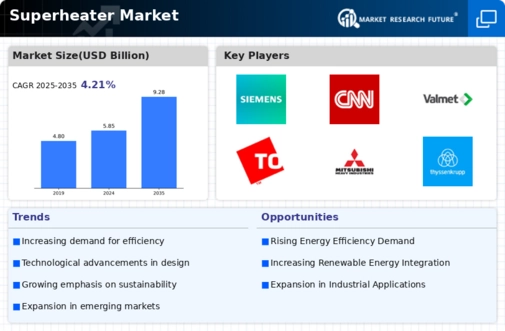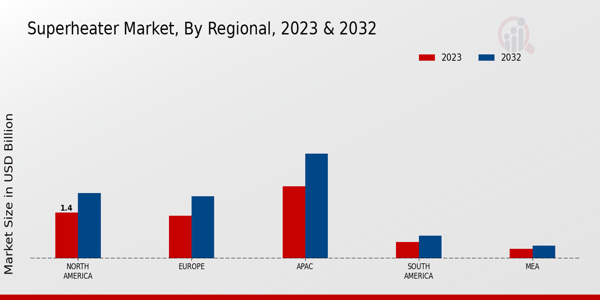Market Growth Projections
The Global Superheater Market Industry is projected to experience substantial growth over the coming years. The market is expected to reach 5.85 USD Billion in 2024 and is forecasted to expand to 9.28 USD Billion by 2035. This growth trajectory indicates a compound annual growth rate (CAGR) of 4.29% from 2025 to 2035. Such projections reflect the increasing reliance on superheaters in various sectors, including power generation and industrial applications. The anticipated growth underscores the importance of superheaters in enhancing energy efficiency and supporting sustainable practices across the globe.
Expansion of Power Generation Capacity
The Global Superheater Market Industry is significantly influenced by the expansion of power generation capacity worldwide. Governments and private entities are investing heavily in new power plants to meet the rising energy demand. This expansion often necessitates the integration of advanced superheating technologies to improve steam quality and increase overall efficiency. For instance, in regions like Asia-Pacific, new coal and gas-fired power plants are being equipped with state-of-the-art superheaters, thereby driving market growth. By 2035, the market is anticipated to grow to 9.28 USD Billion, underscoring the critical role of superheaters in modern energy infrastructure.
Increasing Demand for Energy Efficiency
The Global Superheater Market Industry is experiencing a notable surge in demand for energy-efficient solutions. As industries strive to reduce operational costs and minimize environmental impact, superheaters play a crucial role in enhancing thermal efficiency in power plants and industrial boilers. This trend is particularly evident in regions with stringent energy regulations, where companies are compelled to adopt advanced technologies. The market is projected to reach 5.85 USD Billion in 2024, reflecting a growing recognition of the importance of energy efficiency in achieving sustainability goals.
Growing Industrialization and Urbanization
The Global Superheater Market Industry is also propelled by the ongoing industrialization and urbanization trends across various regions. As countries develop, there is a corresponding increase in energy consumption, necessitating the installation of efficient superheating systems in industrial processes. Industries such as manufacturing, chemical processing, and food production are particularly reliant on superheaters for steam generation. The rising urban population further exacerbates energy demand, prompting investments in infrastructure that includes superheating technologies. This dynamic is expected to contribute to the market's robust growth, aligning with the broader trends of industrial expansion.
Technological Advancements in Superheating
Technological advancements are a pivotal driver for the Global Superheater Market Industry. Innovations in materials and design have led to the development of more efficient and durable superheaters. Enhanced heat transfer capabilities and improved resistance to corrosion and wear are among the benefits of these advancements. For example, the introduction of advanced alloys and coatings has allowed superheaters to operate at higher temperatures and pressures, thereby increasing their efficiency. This trend is likely to sustain the market's growth trajectory, with a projected CAGR of 4.29% from 2025 to 2035, as industries continue to seek improved performance and reliability.
Regulatory Support for Clean Energy Initiatives
Regulatory support for clean energy initiatives is a significant driver for the Global Superheater Market Industry. Governments worldwide are implementing policies aimed at reducing greenhouse gas emissions and promoting the use of cleaner energy sources. Superheaters, which enhance the efficiency of renewable energy systems, are increasingly being integrated into solar thermal and biomass power plants. This alignment with regulatory frameworks not only supports environmental goals but also incentivizes investment in superheating technologies. As such, the market is likely to benefit from favorable policies that encourage the adoption of advanced superheating solutions.











